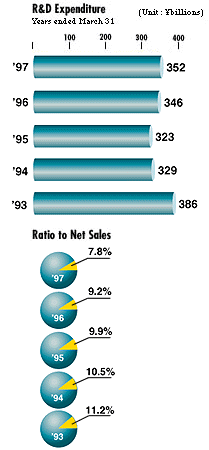 |
 |

 |
 |

 |
Fujitsu continues its strong commitment to research and development, investing
352 billion yen (7.8% of sales) in fiscal 1996. We are using our strong presence
in Japan, the U.S., Asia and Europe to develop leading-edge technologies that
will bring profits and become the de facto standards of the next generation. In electronic devices, Fujitsu developed a novel diagnostic technology for gigabit-class LSI chips, which will be feasible by the beginning of the year 2000. A 0.1 micron scanning-force-microscope probe touches micro lines inside a chip and extracts the voltage signals from the line. Laser beam pulses capture the voltage signals quickly and precisely. The new technology shortens the diagnostic time to 1/1000 that of a conventional electron beam tester. In large-capacity magnetic disks, Fujitsu developed a spin tunnel junction, which shows the largest magneto-resistance change in the world and will be used as the read head for a Giant MR head of the future. Sensitivity is ten times that of a conventional MR head, which will allow future drives equipped with the Giant MR head to store 10 times more information on the same disk surface area. The year 2000 brings with it a calendar year problem for many computer systems. To solve the problem, the company has developed a support system that analyzes the data flow inside the target system including databases. The support system quickly finds groups of calendar year data, thus making it easier to revise the software. In advanced materials, Fujitsu has developed a visualization program that calculates the orbits of electrons (orbitals) based on molecular structure data and displays the molecular orbitals and the distribution of electron density in three dimensions. This program,which brings complicated calculations and graphic processing to the personal computer, will help us develop new materials with new molecular structures in the 21st century. |

Previous | Table of Contents | Next
Copyright (c) 1997 Fujitsu Limited. All Rights Reserved.